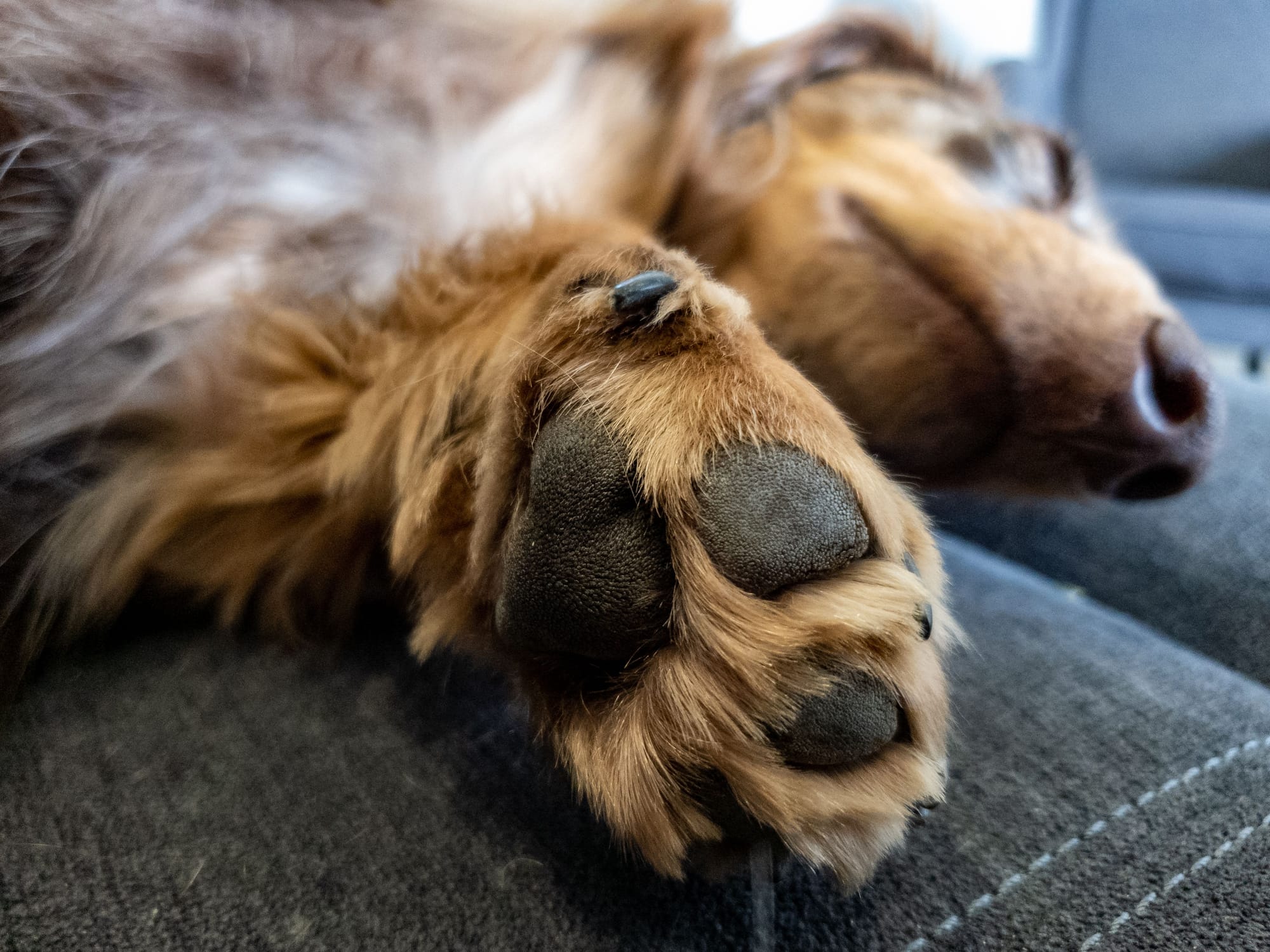Learn the causes behind dog paws turning red and discover effective remedies to keep your furry friend's paws healthy and comfortable. This comprehensive guide explores common triggers, prevention strategies, and treatment options.
Dog paws are adorable and essential for their mobility and overall well-being. However, noticing your canine companion's paws turning red can be concerning.
This article will delve into the various causes behind red dog paws, addressing common triggers, prevention strategies, and effective remedies to ensure your furry friend's paws remain healthy and comfortable. Let's dive into the world of dog paws red and understand how to tackle this issue.

Understanding Red Dog Paws
When it comes to dog paws red, it's essential to understand what it means and the associated symptoms thoroughly. Redness in a dog's paws can indicate underlying issues requiring attention and care. By recognizing the signs early on, you can take appropriate measures to address the problem and prevent further discomfort for your furry companion.
What Does It Mean?
When we talk about dog paws red, we refer to the visible redness or inflammation on a dog's paw pads or between the toes. It is important to note that redness alone is not a definitive diagnosis but a symptom indicating an underlying issue.
Common Symptoms Associated with Red Paws
In addition to redness, several common symptoms may accompany red dog paws:
- Swelling: Swollen paw pads or swollen areas between the toes are often observed alongside redness.
- touching and Scratching: Dogs with red paws may frequently scratch or lick their paws, indicating discomfort or irritation.
- Discoloration: In some cases, the redness may be accompanied by a change in the color of the paw pads, appearing darker or lighter than usual.
- Lesions or Sores: Red dog paws may also develop small lesions, sores, or blisters, further contributing to discomfort and pain.
- Odor: A foul odor emanating from the paws can indicate an underlying infection or dermatological issue.
Understanding these symptoms can help you determine whether your dog's paws are indeed experiencing redness and discomfort. Observing your dog's behavior and looking for these signs to address the issue promptly is important.
By understanding the meaning of red dog paws and recognizing the associated symptoms, you can take proactive steps to identify the underlying causes and provide appropriate care and treatment for your canine companion.
Want to know more about TryFi.com? The Fi Dog Collar is a GPS tracking collar that not only keeps track of your dog’s location, activity levels, and sleep patterns, but it also alerts you if your dog escapes your backyard. This is the fastest way to find your dog after an escape. Try the Fi Dog Collar today!
Causes of Dog Paws Turning Red
Regarding dog paws red, several underlying causes can contribute to this condition. By understanding these causes, you can understand why your dog's paws may turn red and take appropriate measures to address the issue. Let's explore some common triggers behind red dog paws:
Allergies and Irritants
Allergies and irritants are significant contributors to dog paws turning red. There are three main categories to consider:
Food Allergies
Certain ingredients in your dog's diet can trigger allergic reactions, leading to paw redness and inflammation. Common food allergens include wheat, corn, soy, and protein sources like chicken or beef.
Environmental Allergies
Dogs can also be allergic to various environmental factors such as pollen, dust mites, mold, or certain types of grass. When exposed to these allergens, dogs may develop redness and irritation in their paws.
Irritants in the Environment
Chemicals, cleaning products, lawn treatments, or even certain fabrics can act as irritants and cause redness in a dog's paws. These substances can strip away the natural oils from the paw pads, leading to dryness and inflammation.

Infections and Skin Conditions
Infections and skin conditions can also contribute to dog paws turning red. Here are some common culprits:
Bacterial Infections
Bacterial infections, such as interdigital dermatitis or pododermatitis, can cause redness, swelling, and discomfort in a dog's paws. A foul odor often accompanies these infections and may require veterinary intervention.
Fungal Infections
Fungal infections, like yeast infections, can thrive in the moist and warm environment between a dog's toes. They can lead to redness, itching, and a distinct odor. Treating fungal infections typically involves antifungal medications.
Parasitic Infections
Parasites like fleas, ticks, or mites can cause intense itching and redness in a dog's paws. These parasites may also transmit diseases that further contribute to discomfort. Prompt treatment and prevention are crucial in these cases.
Skin Conditions (Dermatitis)
Various types of dermatitis, such as contact dermatitis or atopic dermatitis, can result in redness, inflammation, and itching in a dog's paws. Identifying and avoiding triggers and appropriate medical management can help alleviate the symptoms.
Trauma and Injury
Trauma and injury can lead to red dog paws as well. Here are some common scenarios:
Cuts and Scrapes
Sharp objects or rough surfaces can cause cuts, scrapes, or abrasions on a dog's paw pads, resulting in redness and sensitivity.
Burns and Hot Surfaces
Walking on hot pavement or encountering hot surfaces can cause burns on a dog's paws, leading to redness, blistering, and pain.
Traumatic Injury
Accidents or traumatic incidents, such as getting a paw caught in a door or sustaining an impact, can cause bruising, swelling, and redness in a dog's paws.
By understanding these causes of dog paws turning red, you can narrow down the potential triggers and work towards finding effective solutions. Identifying the underlying cause is crucial in implementing the appropriate treatment and prevention strategies for your dog's red paws.

Preventing Red Dog Paws
Prevention is key to keeping your dog's paws healthy and free from redness. Taking proactive measures can minimize the risk of your furry friend experiencing discomfort and ensure their paws stay in optimal condition. Here are some effective strategies for preventing red dog paws:
Regular Paw Inspections
Regularly inspecting your dog's paws can help you detect signs of redness, swelling, or injury early on. Take the time to examine the paw pads, between the toes, and the nails. Look out for cuts, scrapes, foreign objects, or signs of inflammation. You can address problems promptly and prevent them from escalating by catching them early.
Proper Grooming and Hygiene
Maintaining proper grooming and hygiene practices is essential for paw health. Keep your dog's paws clean by gently wiping them with a damp cloth after walks or outdoor activities.
Trim the nails regularly to prevent overgrowth and potential paw pad injuries. Ensure the fur around the paws is well-maintained and trimmed to avoid trapping moisture or irritants. If your dog does not like to get their nails trimmed, you can try using a Scratch Board.
Minimizing Allergens in the Environment
Minimizing exposure to potential triggers is crucial if your dog is prone to allergies. Keep your home clean and free from dust, pollen, and other allergens. Use hypoallergenic bedding materials, avoid scented cleaning products, and consider an air purifier to improve indoor air quality.
Additionally, if certain outdoor allergens are causing redness, adjust the walking routes or times to minimize exposure.

Protective Paw Gear
Use protective paw gear, such as booties or wax, to shield your dog's paws from hot surfaces, rough terrain, or chemical irritants. These accessories provide additional protection, reducing the risk of redness and injuries. Ensure the booties or wax fit properly and are comfortable for your dog.
Implementing these preventive measures can significantly reduce the chances of your dog's paws turning red. Regular inspections, proper grooming, minimizing allergens, and utilizing protective gear are essential to maintaining healthy paw pads. Remember, prevention is always better than cure regarding your furry friend's well-being.
Treating Red Dog Paws
When faced with red dog paws, addressing the underlying causes and providing appropriate treatment to alleviate discomfort and promote healing is important. Different treatment approaches may be necessary depending on the specific cause of redness. Here are some common treatment options for red dog paws:
Veterinary Consultation
If your dog's paws are red and the symptoms persist or worsen, it's crucial to consult a veterinarian. A professional diagnosis is essential in determining the underlying cause of redness and developing a tailored treatment plan. Your veterinarian will perform a thorough examination, possibly conduct tests, and recommend the most appropriate action.
Professional Diagnosis
A veterinarian will examine your dog's paws and review their medical history to identify the underlying cause of redness. This may involve taking samples for laboratory analysis or performing allergy tests to determine the specific allergens affecting your dog.
Treatment Plan
Your veterinarian will create a treatment plan tailored to your dog's needs based on the diagnosis. This may include antibiotics for infections, antifungal treatments for fungal issues, or allergy medications to manage allergic reactions. They may also recommend topical treatments, changes in diet, or lifestyle adjustments to address the root cause of red dog paws.
Home Remedies and Care
In addition to veterinary care, there are several home remedies and care practices that can help soothe and heal red dog paws:
Soothing Paw Soaks
Gentle paw soaks in lukewarm water with additives like Epsom salt or mild antiseptic solutions can help reduce inflammation and promote healing. Follow the instructions provided by your veterinarian for the appropriate soaking duration and frequency.
Moisturizing Paw Balms
Moisturizing paw balms or pet-safe creams can help combat dryness and soothe irritated paw pads. Look for products specifically formulated for dogs, as human products may contain harmful ingredients. Here is a DIY recipe for a homemade paw balm.
Protective Booties
If your dog's paws are sensitive or prone to injuries, consider using protective booties to minimize further irritation and provide a barrier against environmental irritants. Ensure the booties fit properly and are comfortable for your dog to wear.
Natural Remedies for Allergies
For mild allergic reactions, some natural remedies may provide relief. Consult with your veterinarian about incorporating supplements like omega-3 fatty acids, herbal remedies, or specialized diets that support skin health and reduce allergic responses.
It's important to note that while home remedies and care practices can offer temporary relief, they should not replace veterinary care. Always consult your veterinarian before trying any treatments or remedies on your own.
You can effectively treat dog paws red and promote healing by seeking professional veterinary advice and following appropriate treatment plans combined with home remedies and care. Remember to be patient and consistent in your approach, as some conditions may require time to resolve fully.
When to Seek Veterinary Care
While some cases of red dog paws may resolve with home remedies and preventive measures, there are instances where veterinary care is necessary. It's important to recognize the signs that indicate a need for professional intervention. If you observe any of the following situations, it's time to seek veterinary care for your dog paws red:
Persistent or Worsening Symptoms
If the redness in your dog's paws persists or worsens despite your efforts to address it, it's crucial to consult a veterinarian. Chronic or progressive redness may indicate an underlying condition that requires medical treatment. Your veterinarian can thoroughly examine, diagnose the cause, and recommend appropriate interventions.
Additional Signs of Discomfort or Pain
If your dog exhibits additional signs of discomfort or pain along with red paws, it indicates that veterinary care is needed. These signs may include excessive licking, chewing, or biting of the paws, limping, reluctance to walk, or changes in behavior. Such symptoms could indicate an infection, injury, or a more serious underlying issue that requires professional attention.
Remember, your veterinarian is the best resource for diagnosing and treating the underlying cause of red dog paws. They have the expertise and tools to provide accurate assessments and tailored treatment plans. Seeking veterinary care on time can help prevent further complications and ensure your dog receives the necessary care for their well-being.
Do not hesitate to contact your veterinarian with concerns about your dog's red paws. They are there to support you and your furry friend, offering the guidance and medical care needed to address the issue effectively.
Conclusion
Red dog paws can be a concerning issue for dog owners, as they often indicate underlying problems that require attention and care. By understanding the meaning of red dog paws, recognizing the symptoms, and identifying the causes, you can take proactive steps to prevent and treat this condition.
Prevention plays a crucial role in maintaining healthy paw pads. Regular inspections, proper grooming, minimizing environmental allergens, and utilizing protective gear can help reduce the risk of redness and injuries. However, despite our best efforts, red dog paws may still occur.
When faced with red dog paws, it is important to seek veterinary care if the symptoms persist or worsen or if your dog exhibits signs of discomfort or pain. A veterinarian can provide a professional diagnosis, create a tailored treatment plan, and recommend appropriate medications or interventions based on the underlying cause.
Home remedies and care practices can complement veterinary treatment by providing soothing relief and supporting healing. However, it is essential to consult with your veterinarian before attempting any home remedies or treatments.
Remember, your dog's well-being is of utmost importance. By being attentive to your dog's paw health, seeking veterinary care when necessary, and implementing preventive measures, you can ensure your furry companion's paws stay healthy and free from redness.
Taking care of your dog's paws promotes their overall comfort and happiness and strengthens the bond between you and your loyal companion. So, stay vigilant, prioritize their paw health, and enjoy many happy adventures together.

